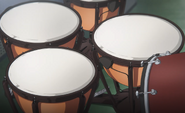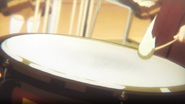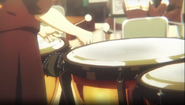The Timpani (ティンパニ Tinpani), also called Kettledrums, is an instrument in the percussion family. Someone who plays the timpani is called a timpanist.
Construction[]
It is a large bowl-shaped drum, typically made of copper, with a membrane, called the drum head, stretched across the top, which can be tightened or loosened to play different notes when struck.
Performance[]
The timpani is one of the most difficult percussion instruments to play. Players are required to quickly and accurately tune each drum accordingly, by using the pedals at their feet. These pedals are connected to the 6-8 tension rods which control the tightness of the drum head. However, this mechanism is much more practical than early timpani, which had to be manually tuned by twisting or untwisting a series of screws, which would also change the pitch of the instrument.
Because pieces sometimes call for quick changing of pitch while performing, timpanists often sit, unlike other percussionists, lest they lose balance or change the pitch inappropriately as a result. On some models, gauges connected to the pedal exist that can help a player tune to a note without listening for intonation.
Striking the drum also requires a great degree of skill. As timpani are most often used as a rhythmic tool, the timpanist requires a good sense of rhythm. Additionally, players must determine which mallet will be appropriate for each passage. The timpani's part can often be exhaustive, requiring rolls (formally called tremolo), the quick repeated beating of the drum to provide a sustained effect. These can last up to several minutes in length. Generally, the drum is struck four inches away from the rim, but this can change depending on the desired effect.
The length of the note produced can be controlled by the player by pressing their hand against the drum head after it is struck. This will mute the drum, and can be used to provide a more staccato effect.
A portamento effect (not to be confused with glissando) can be achieved by changing the tuning of the drum immediately after having struck it.
Scoring[]
The timpani is an essential member of symphony orchestras, concert bands, and as part of marching band front ensembles. It is standard to have a single part written for 4-5 individual timpani. In many cases, like orchestras, they are the only pitched membranophones.
Timpani have their own part in musical scores, unlike most other percussion instruments which fall under "Percussion 1, 2, 3, etc..". This is because timpanists typically do not switch instruments throughout a piece, and in many professional ensembles, the timpanist only plays timpani, rather than switching between instruments like a regular percussionist.
As portrayed in Hibike! Euphonium[]
- Miyoko Oono plays the timpani in several pieces, such as Crescent Moon Dance.
- Motoko Higashiura plays the timpani in Liz and the Blue Bird.
Gallery[]
| Musical instruments in Sound! Euphonium | |
|---|---|
| Woodwinds | |
| Brass | |
| Strings | |
| Percussion | |
| Other | |












